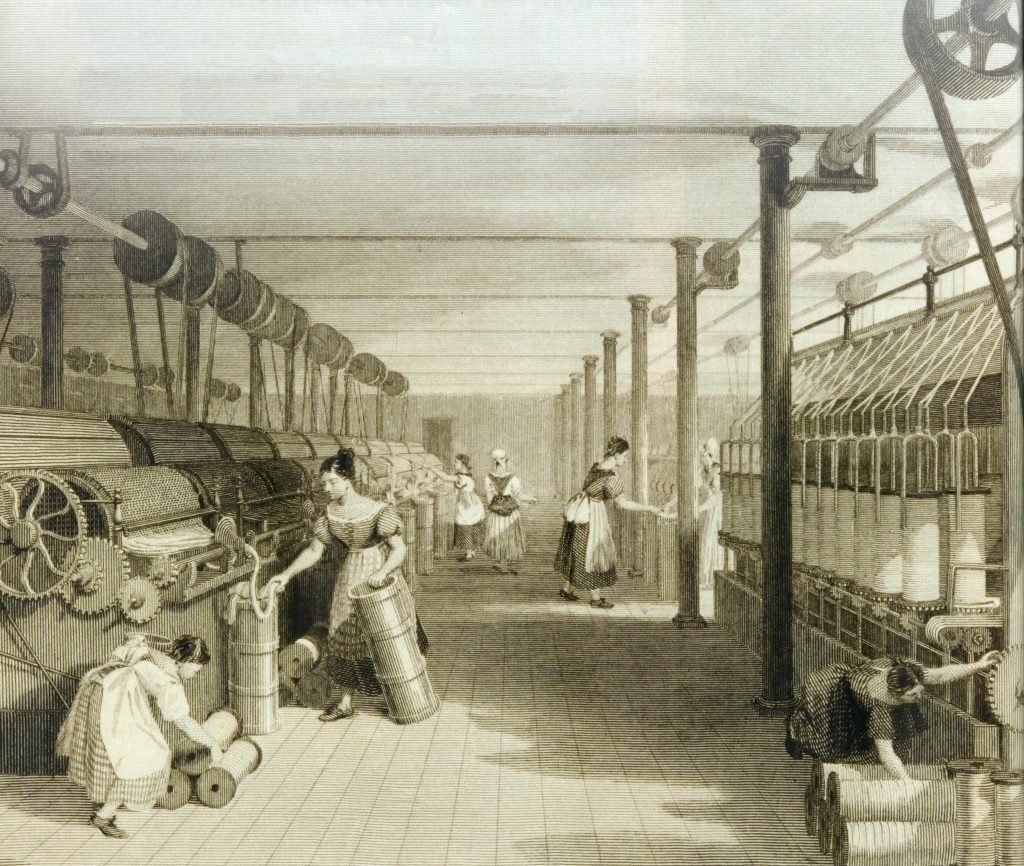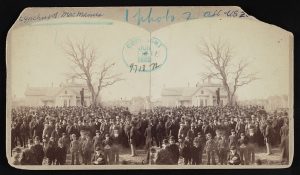Children today spend five days a week going to school for eight hours. During the first half of the nineteenth century in Britain, this was not the case. Instead, children even as young as five or six would toil all day long in factories or in mines. They had no breaks, no time off, and no schooling. Their work often led to horrible accidents, children being injured for life, and children left without an education.
Children laboring, of course, did not start with the British Industrial Revolution. It had been a normal part of life in Europe since the middle ages, when children helped their parents on farms and with household work. The people’s perception of this work, however, changed during the Industrial Revolution, since that is when people began to see this new kind of labor, factory labor, as an injustice and even criminal.1
The Industrial Revolution began in Britain during the 1780’s and rapidly changed the work process and the social relations of work. Prior to the Industrial Revolution, most people worked directly in the production of food, usually as farmers on their own farms. When textile factories began forming in the new factory cities, instead of working on their farms and making what their family needed, people left their farms and moved into the factory cities to make a living. Factory conditions of work, however, were far different from the work rhythms of farm life. In fact, they were brutal in comparison. Factory workers would typically put in between 12 and 16 hour days, working for meager wages. The machines they attended were dangerous, and the workers were often on their feet throughout the day, with perhaps a half-hour break for meals. Among these workers were children, many of whom were as young as five or six years old. Children were valued as workers for their small stature and ability to climb into small places and do things that adults often could not do. This often resulted in mutilation and the loss of appendages for many of these children.2
Children were also valued as workers by the factory owners because of the low wages that they were paid. Men were paid the most in factories, followed by women and then children. These wages, however small, were needed by the families of these children simply to survive. The parents often sent their children out to work to help pay for rent, food, and otherwise help make ends meet.3
One reason that the British public became outraged by child labor practices was the fact that children in factories were not receiving an education. Horace Mann, an American educational reformer, stated:
No greater calamity can befall us as a nation than that our children should grow up without knowledge and cultivation. If we do not prepare them to become good citizens, develop their capacities, enrich their minds with knowledge, imbue their hearts with a love of truth and all things holy, then our republic must go down to destruction as others have gone before it.4
This represents the thoughts of the British at the time, which was being echoed in the United States during its own industrial revolution. People wanted to ensure the future of their nation, which starts with the young. They believed that children should attend school for at least a while.5 This led to several laws being passed to raise the legal age of work.
In 1833, the British Parliament passed the Regulation of Child Labor law to help improve the working conditions for children in factories. The Law limited the age of workers, saying that they had to be older than nine with an age certificate to prove it, and that children 9-13 could not work for more than nine hours a day. Additionally, children 13-18 were not permitted to work longer than twelve hours a day. Along with these work-hour restrictions, the law also made school attendance a two-hour requirement, and said that children could not work at night. Fines for breaking these rules were small, however, so they were frequently violated, often with impunity.6

Many other pieces of legislation were also passed to place limits on the gender, hours, and ages of workers. The Mining Act of 1842 prevented women and girls from working in mines, and the Ten Hours Bill of 1847 set ten as the maximum number of daily working hours for women and children. This act was hated by factory owners because they believed it would hurt the textile industry’s competitiveness worldwide. After these bills, others followed to ensure their effectiveness, and to ensure that they would be properly implemented.7
By 1900, the minimum working age had been raised to twelve years of age and child labor had decreased drastically in Great Britain. However, the introduction of legislation against child labor provoked its share of protests as well. Because of these protests, Parliament established commissions to collect evidence of abusive practices. These were called the Blue Books or Sadler Reports. They interviewed children, parents, factory workers, owners, and even doctors on the condition of children in textile factories. Unsurprisingly, the reports uncovered a range of serious abuses by factory owners and overseers. Unfortunately, most critics just said that the claims were exaggerated in order to continue their money making practices.8
The legislation surrounding the British Industrial Revolution had become very effective by 1900, and child labor and its accompanying abuses had decreased dramatically. By 1900, most children were attending school instead of working in factories. The laws passed finally added up to changing British child labor to being closer to what we see today, a mostly child-free labor system, with children going to school and adults having regulated working hours.
- World History Encyclopedia, 2011, s.v. “Child Labor and Child Labor Laws in Early Industrial Great Britain.” ↵
- James D. Schmidt, “Broken Promises: Child Labor and Industrial Violence,” Insights on Law & Society, no. 3 (Spring 2010): 14–17. ↵
- Robert Whaples, “Hard at Work in Factories and Mines: The Economics of Child Labor during the British Industrial Revolution,” Business History Review, no. 2 (2001): 429. ↵
- Friends’ Intelligencer vol. 28 no. 1 (1871): 336. ↵
- James D. Schmidt, “Broken Promises: Child Labor and Industrial Violence,” Insights on Law & Society, no. 3 (Spring 2010), 14–17. ↵
- Great Britain, “Factories Regulation Act” (1833). ↵
- Steven Toms and Alice Shepherd, “Creative Accounting in the British Industrial Revolution: Cotton Manufacturers and the ‘Ten Hours’ Movement,” MPRA Paper, No. 51478 (2013), 6-8. ↵
- World History Encyclopedia, 2011, s.v. “Child Labor and Child Labor Laws in Early Industrial Great Britain.” ↵



141 comments
Jose Maria Gallegos Cebreros
First of all, congrats on your great article. Your article was very informative and I can see there is a lot of research involved. It is impressive to read about how the industrial revolution made the population adapt to the new needs that the industry had, and how there was a lot of child-labor in order to cover it. I enjoyed reading your article a lot!
Ana Diaz
Great article! It is so shocking how much children were exploited during the industrial revolution and throughout the early 1900s. I remember learning in high school that families would have more children just to have more workers and to bring in more money. It is extremely sad and I am glad that in today’s world kids are allowed to be kids more and not be forced to work for someone else’s greed.
Alejandro Fernandez
In this article, the author discusses child labor during the British Industrial Revolution. Specifically, the harsh conditions endured by children as young as five in which they experienced twelve-hour workdays. Ultimately, it’s interesting to see the difference in eras in which young children were forced to work to support their families versus now where the legal age of employment is sixteen. Overall, this article is well-written and informative.
Christopher Morales
First of all, you made a great title that really stuck out to me. I felt the title and gained sympathy for the children right from the start. Based on our understandings today, I cannot even comprehend the idea of child labor as something being okay. This is a part of history to remember and learn from. The shift in mindsets that encouraged more sympathy and equally really changed the landscape for child labor. We should all be happy it did. Education became an important idea which also helped alleviate the child labor issue. Thank you for bringing an article that talks about this issue in history. It is necessary to remember.
Azeneth Lozano
This was a well written and an interesting article with some things that are not heard of. Working conditions were harsh during this time for everyone, even as young as 5 years old and suffering the same work conditions as a 25 year old. Thankfully, the Child Labor laws came into effect thus causing children to receive education and not work in such life risking industries.
Melyna Martinez
This article shows why labor laws and especially child laws were implemented. Seeing not only the struggle men had in the teh labor force but children and women alike. Especially the conditions that English children went through at that time, which were deadly almost. I also believe we can see how much society has changed as now children would never experience situations like this, which in a way stopped because of the effect they had.
Anna Steck
It is crazy to think of all the ways we have changed our view of what it means to be a kid. The initial legislation that was put in place was pretty shocking. It seamed to prevent work conditions that could be abusive for people of any age. I mean 9 hour work days for 9- 13 year olds is pretty crazy. The article was chronological, interesting and clear. Great work.
Peter Alva
Looking into this article there was only one thing I knew about child labor and that was the laws in America about Child Labor. I was unaware of how bad it was in Britain and I say that meaning that I was unaware that they actually did this. It’s hard to think that those kids go to work in some of the craziest working conditions especially kids in the coal factories. Its forcing these kids to put food on the table for families
Marie Peterson
Seeing how things have changed over the years is so interesting. Children used to work to the point of injury and now most places will not hire younger than 18. Child labor was a horrible practice in the United States and Britain throughout the Industrial Revolution and fortunately, this has stopped in those countries. However, it continues to be a huge problem in other countries. Articles like this show how history can teach us the right thing to do. Great job!
Noelia Torres Guillen
This was a very informative article! Im glad you choose to talk about how during the British industrial revolution child labor was seen as the way to go because it was cheaper. I remember every time we learn about the industrial revolution, American and British, we would talk about the terrible conditions children were placed under. The work place conditions, if it was dangerous or baldy managed, didn’t matter to employers. But I’m glad that we created international laws to help prevent child labor and denormalize it.